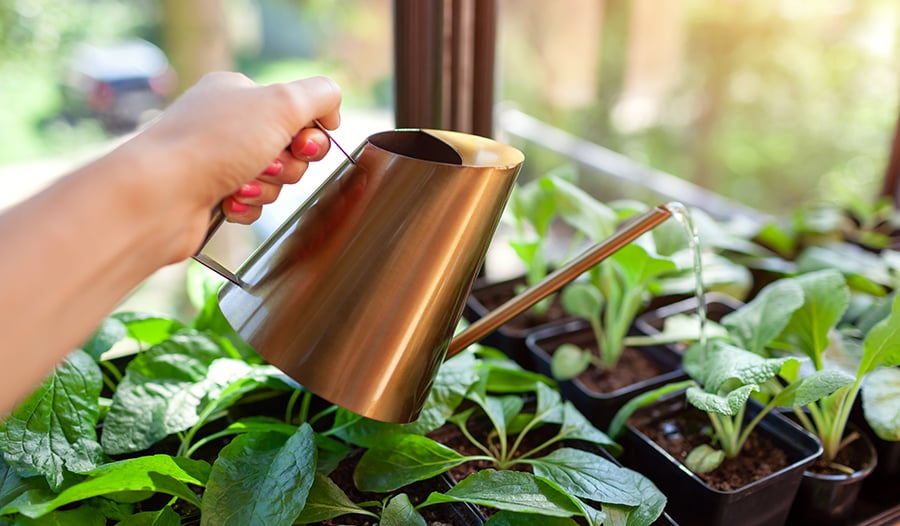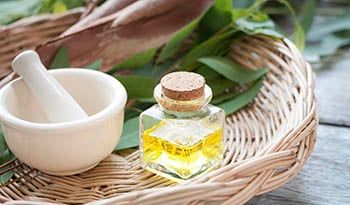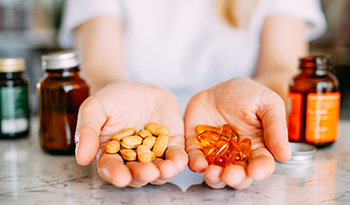5 Mullein Leaf Benefits

Mullein leaf is a popular and versatile herb that continues to gain popularity among the general public and those interested in health and wellness.
Mullein leaf has been used for centuries as a medicinal herb for a variety of health conditions, the chief of which usually consists of respiratory complaints and supporting lung health.
But does modern research support traditional use? Studies suggest that the answer is yes. With more research supporting the traditional uses of mullein leaf and elucidating new ones, more benefits to mullein leaf are being discovered with each new study published.
What Is Mullein Leaf?
Mullein, scientifically known as Verbascum species, is a biennial plant with sage green colored leaves that grow close to the ground in its first year. The leaves are covered in fine white hairs giving them a velvety appearance. In its second year, mullein grows a large stalk of yellow flowers that can reach between 5 to 10 feet tall.
Mullein is native to the areas of central and western Asia, Europe, and northern Africa. It was first introduced to North America in the mid-1700s where it was widely used as a fish poison. While mullein may be poisonous to certain fish, it has a rich history of use as a traditional medicinal for respiratory conditions like asthma, bronchitis, and dry coughs. Traditional uses of mullein even extended to infectious respiratory diseases like tuberculosis and whooping cough.
Traditionally, the most common way to consume mullein leaf was as a tea strained through a fine cloth to prevent contact dermatitis, an itchy rash, around and inside the mouth. The contact dermatitis associated with mullein leaf tea was caused by the fine white hairs on the leaves. Mullein leaf was also dried and smoked in fires or pipes as a traditional therapeutic.
Research has found that mullein leaf has some incredible phytonutrients. Some of the phytonutrients found in mullein include saponins, flavonoids, glycosides, and hesperidin. Mullein also contains vitamin C and a variety of minerals.
While mullein leaf has a history of use for respiratory conditions, studies show that this awesome herb may also have anti-inflammatory, pain-reducing, antimicrobial, antioxidant, and skin-soothing properties.
5 Mullein Leaf Health Benefits
1. Mullein Leaf May Benefit Respiratory Health
When it comes to lung health and wellness, mullein leaf is often at the top of a list including other respiratory supplements like elecampane and usnea. Mullein leaf is often one of the most common herbs used for respiratory support because it has a wide range of plant molecules that allow it to act on lung tissues in a variety of beneficial ways. For example, studies show that some of the constituents in mullein leaf allow it to act as both an expectorant and a demulcent.
Expectorants are medicines or herbal supplements that help to clear mucus from the lungs by thinning mucus production and promoting cough. Demulcents are soothing agents that reduce inflammation on the skin or mucus membranes by creating a protective layer over the inflamed tissues. The expectorant properties of mullein are thought to come from saponins that promote fluid production in the lungs. The demulcent properties come from polysaccharides, and carbohydrates that form mucilage to soothe inflamed mucus membranes and skin. The unique combination of expectorant and demulcent found in mullein leaf may benefit conditions like bronchitis and chronic obstructive pulmonary disease or COPD.
Studies suggest that mullein may also reduce asthma because of its anti-inflammatory effects. Research shows that one of the plant nutrients in mullein leaf is flavonoids. Flavonoids are a group of naturally occurring molecules that have anti-inflammatory properties.
2. Mullein Leaf May Benefit Skin Health
Since mullein has demulcent properties, studies suggest that this versatile herb may benefit skin health. Older studies indicate that mullein leaf may benefit hemorrhoids if used as a poultice. A poultice is a soft mass of material that is placed on an inflamed or irritated portion of the body and kept in place by a cloth to relieve pain and reduce inflammation.
Mullein leaf poultices may also have potent wound-healing properties. Traditional uses of mullein leaf include soothing eczema by reducing skin inflammation and wound healing. Studies are beginning to support these traditional uses. One animal study assessed the wound healing and antioxidant properties of mullein leaf. The study tested an extract of mullein leaf on skin scratches against nitrofurazone and an unnamed simple ointment.
Nitrofurazone is an antibacterial topical medication that treats burned skin infected with pathogenic bacteria. The study found that the mullein leaf ointment promoted more elasticity in the wounded skin than both the simple ointment and nitrofurazone. The skin treated with mullein leaf ointment also exhibited less oxidative stress. This finding suggests that mullein leaf also acts as an antioxidant to promote wound healing.
Another animal study used an extract of mullein to assess the wound healing property of the herb against gotu kola or Centella asiatica. The study found that mullein leaf was able to promote wound healing effectively.
Human studies on mullein leaf are beginning to mimic the findings of animal studies. One double-blind randomized placebo-controlled study followed 93 women who had experienced one pregnancy and had an episiotomy. An episiotomy is a surgical procedure that involves making an incision at the vaginal opening to assist in childbirth. The study assessed the efficacy of a mullein leaf cream to heal the incision against a placebo. The women were assigned to either the mullein leaf cream group or placebo and applied the cream twice a day for 10 days. After 10 days, the study found that the mullein leaf cream was superior to placebo for wound healing.
3. Mullein Leaf May Be Anti-inflammatory
With aging comes an increased risk of long-term inflammation. Chronic Inflammation is linked to increased joint pain, decreased range of motion, and increased risk for diseases like osteoarthritis.
Mullein leaf supplements may help to reduce the inflammation and cartilage damage associated with osteoarthritis. One test-tube study investigated the ability of mullein to decrease inflammation in cartilage cells that mimicked the damage that comes with osteoarthritis. The study compared mullein against Devil’s Claw to assess which herb would be more effective as an anti-inflammatory. The study found that the mullein leaf extract was more effective at reducing inflammation caused by osteoarthritis than Devil’s Claw, a potent anti-inflammatory.
4. Mullein Leaf May Help Reduce Pain
The anti-inflammatory potential of mullein leaf may also translate into pain reduction. Higher amounts of inflammation are linked to a greater perception of pain in the body. One animal study found that mullein leaf extract was able to reduce pain similarly to aspirin. Furthermore, mullein leaf provided faster relief from pain than aspirin.
Mullein leaf may also be an effective pain reliever for those suffering from acute ear infections. Mullein leaf and garlic oil have been an often recommended approach to ear infections in both kids and adults alike in naturopathic medicine.\ One study followed 103 children between the ages of 6 and 18 years of age who had been diagnosed with pain associated with acute otitis media, or an infection of the middle ear. The children were randomly assigned to receive either mullein and garlic oil drops or ear drops to reduce pain. After three days, the amount of pain in both groups was assessed. The study found that the mullein and garlic drops were just as effective as the pain-reducing medicine at relieving pain from an ear infection.
5. Mullein Leaf May Be a Potent Antimicrobial
With the ever-growing concern over superbugs that are resistant to conventional medications like antibiotics and anti-parasitics, wide-ranging and effective antimicrobial interventions are needed. Mullein leaf may be one of those interventions. Studies suggest that mullein leaf has a wide range of antimicrobial activity. One test-tube study assessed the antimicrobial activity of mullein against both Gram-negative and Gram-positive bacteria. Gram-negative bacteria are thin-cell walled while Gram-positive bacteria have thick cell walls. The study found that mullein leaf extract was effective against both Gram-negative and Great positive bacteria although the Gram-negative bacteria were less affected by the mullein extract.
Mullein leaf may also be effective against parasites. One study assessed the efficacy of mullein leaf as an anthelmintic against albendazole. Anthelmintics are drugs or substances that kill parasitic worms. The study found that high concentrations of mullein leaf were just as effective at killing the roundworms and tapeworms as albendazole.
While studies suggest that mullein may be a broad-ranging antimicrobial, one study investigating its effects against harmful fungi found that it didn’t have any effect.
Summary
Mullein leaf is a powerful and versatile herb that has been used for centuries for a variety of health conditions. Although mullein is traditionally associated with respiratory health and wellness, modern research suggests that it may be beneficial for skin health as well as for reducing inflammation.
References:
- Ali N, Ali Shah SW, Shah I, et al. Anthelmintic and relaxant activities of Verbascum Thapsus Mullein. BMC Complement Altern Med. 2012;12:29. Published 2012 Mar 30. doi:10.1186/1472-6882-12-29
- Asefa M, Teshome N, Degu A. Anti-Inflammatory and Analgesic Activity of Methanolic Root Extract of Verbascum sinaiticum Benth. J Inflamm Res. 2022;15:6381-6392. Published 2022 Nov 22. doi:10.2147/JIR.S389430
- Asgarpanah J, Hashemi SJ, Hashemi E, Askari K. In vitro antifungal activity of some traditional Persian medicinal plants on pathogenic fungi. Chin J Integr Med. 2017;23(6):433-437. doi:10.1007/s11655-015-2181-7
- Blanco-Salas J, Hortigón-Vinagre MP, Morales-Jadán D, Ruiz-Téllez T. Searching for Scientific Explanations for the Uses of Spanish Folk Medicine: A Review on the Case of Mullein (Verbascum, Scrophulariaceae). Biology (Basel). 2021;10(7):618. Published 2021 Jul 2. doi:10.3390/biology10070618
- Calabrese G, Zappalà A, Dolcimascolo A, Acquaviva R, Parenti R, Malfa GA. Phytochemical Analysis and Anti-Inflammatory and Anti-Osteoarthritic Bioactive Potential of Verbascum thapsus L. (Scrophulariaceae) Leaf Extract Evaluated in Two In Vitro Models of Inflammation and Osteoarthritis. Molecules. 2021;26(17):5392. Published 2021 Sep 5. doi:10.3390/molecules26175392
- Grigore A, Colceru-Mihul S, Litescu S, Panteli M, Rasit I. Correlation between polyphenol content and anti-inflammatory activity of Verbascum phlomoides (mullein). Pharm Biol. 2013;51(7):925-929. doi:10.3109/13880209.2013.767361
- Gupta A, Atkinson AN, Pandey AK, Bishayee A. Health-promoting and disease-mitigating potential of Verbascum thapsus L. (common mullein): A review. Phytother Res. 2022;36(4):1507-1522. doi:10.1002/ptr.7393
- Karman, Rachelle. (2016). Assessing the Effectiveness of Mullein on Respiratory Conditions Such as Asthma. 10.13140/RG.2.2.28242.76483.
- Lulseged K, Akele MZ, Abiye AA, Abebe B, Assefa Huluka S. Wound Healing and Antioxidant Properties of 80% Methanol Leaf Extract of Verbascum sinaiticum (Scrophulariaceae): An Ethiopian Medicinal Plant. Evid Based Complement Alternat Med. 2022;2022:9836773. Published 2022 Sep 8. doi:10.1155/2022/9836773
- Mahdavi S, Amiradalat M, Babashpour M, Sheikhlooei H, Miransari M. The Antioxidant, Anticarcinogenic and Antimicrobial Properties of Verbascum thapsus L. Med Chem. 2020;16(7):991-995. doi:10.2174/1573406415666190828155951
- Sarrell EM, Mandelberg A, Cohen HA. Efficacy of naturopathic extracts in the management of ear pain associated with acute otitis media. Arch Pediatr Adolesc Med. 2001;155(7):796-799. doi:10.1001/archpedi.155.7.796
- Süntar I, Tatlı II, Küpeli Akkol E, Keleş H, Kahraman Ç, Akdemir Z. An ethnopharmacological study on Verbascum species: from conventional wound healing use to scientific verification. J Ethnopharmacol. 2010;132(2):408-413. doi:10.1016/j.jep.2010.08.004
- Taleb S, Saeedi M. The effect of the Verbascum Thapsus on episiotomy wound healing in nulliparous women: a randomized controlled trial. BMC Complement Med Ther. 2021;21(1):166. Published 2021 Jun 8. doi:10.1186/s12906-021-03339-6
- Turker AU, Gurel E. Common mullein (Verbascum thapsus L.): recent advances in research. Phytother Res. 2005;19(9):733-739. doi:10.1002/ptr.1653
DISCLAIMER:This Wellness Hub does not intend to provide diagnosis...













































































 Table of Contents
Table of Contents














